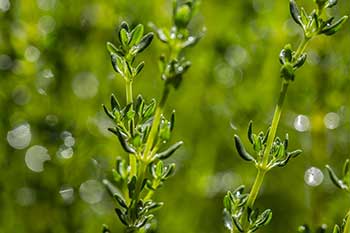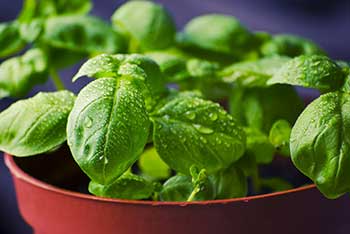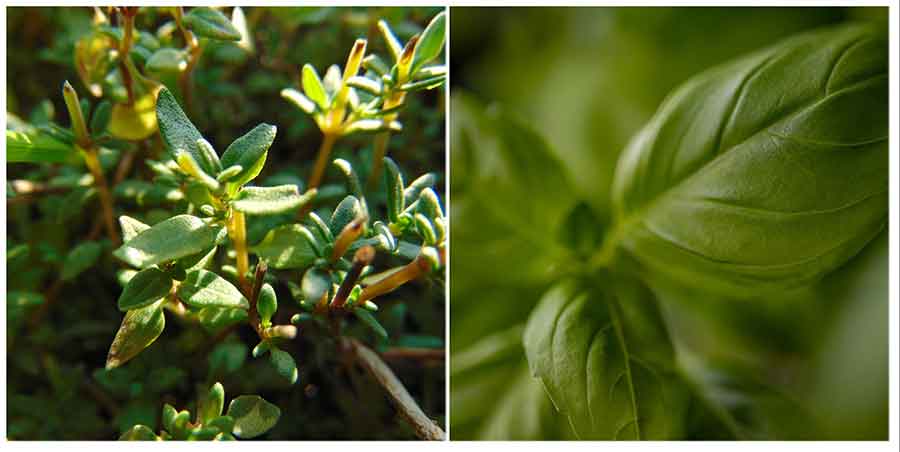When it comes to container gardening, there are so many plants that you can choose to grow. You can plant edible fruits such as peppers and tomatoes. Choosing to plant salad greens such as rocket or lettuce is also another great option.
In my garden, I always reserve a special place for growing my herbs. At any time of the year, I always have a fresh supply of basil, sage, oregano, tarragon, dill, parsley, and thyme. I grow them not only for their culinary purposes but also for their medicinal benefits.
With so many herbs to plant, sometimes I plant 2 or 3 kinds of herbs in a single container. However, not all herbs can be planted this way. Two of the popular herbs grown around the world are basil and thyme.
Can thyme and basil be planted together? Based on their soil requirements, thyme and basil should not be planted together. Thyme thrives well in dry soil, while basil likes damp, moist soil. With their differences in soil conditions, they are best planted in separate containers.
Herbs That Can Be Planted Together with Thyme

Instead of planting basil with thyme, consider other herbs that can tolerate dry soil or drought-like conditions. Here are some herbs that can be planted together with thyme:
Tarragon
Tarragon can tolerate drought, so it needs no intense watering, especially when planted in a well-drained potting mix.
It can also grow under shade but prefers full sun. Tarragon is a licorice-flavored herb that is often used to flavor meats or egg dishes. It is used both fresh and dried. Tarragon is a hardy herb usually grown for its leaves and its aromatic flavor.
Tarragon plants can reach up to 3 feet tall. The herb has long, light green leaves and yellow or white flowers.
Lavender
Lavender, like tarragon, can tolerate drought, too. It loves full sun but hates fertilizers. Lavender is most commonly used in aromatherapy.
The fragrance from the oils of the lavender plant is believed to help promote calmness and wellness. It's also said to help reduce stress, anxiety, and possibly even mild pain. Use lavender as a natural pest repellent near patios and porches. The scent deters mosquitoes, flies, fleas, and other problem insects.
Lavender herbs will display purple colored blooms through the summer months, attracting an array of beneficial insects to the garden, such as butterflies, bumblebees, honeybees, and hummingbirds as well.
This highly aromatic compact form of lavender is ideal for low hedging, borders, or pots. Its long-lasting perfumed flowers attract friendly insects, and the grey-green leaf color creates a pleasant contrast in the garden.
Oregano
Oregano loves well-draining potting mix and full sun. The more sun it receives, the more pungent the leaves. It doesn't like wet soil. Oregano has a sweet aromatic flavor. With its Mediterranean heritage, it's the ideal herb to use in Italian and Spanish-style dishes.
Oregano is a grab-and-go herb that pairs well with chicken, scrambled eggs, baked eggplant, burgers, and even fish. Grow it in a warm spot outside or keep it in a pot on a sunny balcony.
Rosemary
Rosemary loves hot, dry spots and quick-draining soil. It can tolerate drought. Do not wet when grown indoors.
It is a slow-growing perennial that will not be ready to harvest in its first year. The herb originated in the Mediterranean so it likes the hot weather.
It doesn't only give you fresh herbs to cook with but it also is a pretty bush with a wonderful aroma. Thanks to its fine aroma, the plant branches have been widely used in cookery for the preparation of many dishes.
The substances which are contained in rosemary improve mood, reduce stress, and helps condition your skin.
Sage
Sage is best-grown in full-sun, well-drained potting mix. Sage is a perennial, evergreen sub-shrub, with grayish-green color and lance-shaped leaves.
It has a high antioxidant capacity to protect the body’s cells from damage that may lead to cell death, a weak immune system, and chronic diseases. It has also anti-inflammatory, anti-fungal, and anti-microbial effects that are beneficial to human health.
Over the years, it has been regarded as one of the useful medicines to cure mental disorders and gastrointestinal ailments. Sage is a fairly drought-tolerant herb, and even when the leaves look wilted, a little water perks the entire plant right up.
Wait until the soil is dry to give it a thorough watering.
Dill
Dill is a popular herb that is used as a seasoning in many different kinds of dishes such as soups, salad dressings, and pickling recipes. It is a fern-like, fragrant plant with a great flavor.
In addition to its fragrant foliage, dill also produces yellow blooms that can be used in bouquets, or the green ferns can be used as filler. Dill can reach up to 3 feet tall.
Herbs That Can Be Planted Together with Basil
The following herbs can be grown together with basil. These are herbs that grow well in moist soil. You may need constant watering for these kinds of herbs. However, be careful also not to overwater. Overwatering can damage the plant’s roots which will stop them from absorbing nutrients from the soil.
Chives
Chives are tiny onions and grown for their flavorful leaves and flowers, which bloom purple. They bloom well in well-drained potting soil with plenty of organic matter. While they can grow well in shade, they thrive best in full sun.
They are usually grown from bulbs and are easy to grow indoors. Both onion and garlic chives can be grown and used in the kitchen to add a punch of flavor to many dishes. The flowers are edible as well and can be floated in soups. Chives grow best in clumps, and they can be grown in small pots for a container garden.
The leaves of onion chives are hollow and the leaves of garlic chives are flat. Chives plants also have insect-repelling properties and can be used in gardens to drive away unwanted pests.
Coriander
Coriander, sometimes called cilantro, can grow well under some shade but grows best under the sun. Plant in deep containers as it has a long taproot.
This glorious herb can be used in many Asian dishes, paired with fish, soups, salads, and even ground into pesto. You can use the whole plant –leaves, stems, roots, and seeds, too.
Parsley
Parsley grows slow. Because it requires low maintenance, however, and can live up to nearly two years, parsley is a good choice for your herb garden. Do not cut the initial leaves. A compact and vigorous plant, it is ideal for garnishes and flavoring.
The nutritious leaves are high in iron and in vitamins A, C, and E. The high chlorophyll content makes it a natural breath sweetener, too. Its high chlorophyll content also makes it a natural breath sweetener. It grows well in containers
The entire herb—stem and all—can be used for flavoring stocks, soups, and sauces, but more often the leaves are stripped from the stems and chopped before adding to a recipe. They can be used as an ingredient in recipes such as meatballs and meatloaf or added as a flavoring at the end of cooking.
Whole leaves can be incorporated into salads and used as a garnish.
Fennel
Fennel is a bulbous vegetable with overlapping layers similar to cabbage and long fronds resembling dill. The fronds can be used in salads, but the vegetable is often grown for its bulb, which produces a crunchy texture with a taste similar to licorice.
The bulb can be grilled until tender, or sliced thin for use in slaws and salads.
Tips for Growing Thyme
Thyme is one of the most commonly used herbs in the world. Tiny, yet very aromatic, thyme leaves are good in potato and bean salads as well as in warm salads with beef and duck. You can grow it in your garden and use it fresh or dried in all kinds of dishes.
The flowers, leaves, and oil are used as medicine. Thyme is sometimes used in combination with other herbs.
To grow thyme, sow seeds 5mm deep in a good potting mix. Sprinkle seeds on top of the soil. Do not bury the seeds, just let them lay on top. Gently press the seeds onto the soil using your finger. Water/spray the seeds lightly and do not overwater.
Cover the top of the container with plastic. This will give the seeds a greenhouse effect and proper humidity. Transplant when it reaches 6 inches in height.
Tips for Growing Basil

Basil belongs to the mint family. It has 35 varieties, including Thai basil, lemon basil, and holy basil. Traditional in a pesto dressing, basil's small leaves have a pungent and delicious flavor. It usually is scattered over any tomato salad, but particularly one with mozzarella cheese.
Basil grows best in warm weather, and basil seeds should be planted after all dangers of frost have passed. Plant seeds 1/4 inch deep and 12 inches apart. Seeds can be started indoors to get a head start on growing the herb.
Plant indoors six weeks before the last frost date and place in a sunny windowsill. Plant in moist soil that is well-drained. If planting in a container, use a larger pot to prevent plants from drying out in the summer heat.
Basil needs six to eight hours of sun per day. Water the plants freely during dry periods and once flowering begins, pinch off the flower heads to encourage the leaves to continue to grow. Basil does best in soil with a pH of 6 to 7.
Since basil likes moisture, place mulch in the pot or around the plants to help retain moisture. Basil should be pruned once the plant has six to eight leaves. After the basil plant is six weeks old, pinch off the center shoot to keep flowering at bay.
Basil grows well if planted near tomatoes in the garden. The biggest threat to a basil plant is root rot from poor drainage, so ensure the planting site has adequate drainage. Also, watch out for pests such as aphids, slugs, or Japanese beetles.
Basil and Thyme are Rich in Vitamin A
If you are into urban or container gardening, I would suggest planting basil and thyme in separate containers. When you harvest these herbs, you get a healthy dose of Vitamin A. According to the U.S. Department of Agriculture (USDA), basil contains 105% and thyme has 95% of Vitamin A per 100 grams. This is based on the Percentage of Daily Value.
Vitamin A is essential for healthy vision, eyes, skin, and growth. It can also be obtained from beta-carotene, the pigment found in highly colored fruit and vegetables. In addition to acting as a source of vitamin A, beta-carotene has an important role to play as an antioxidant in its own right.
It also acts as an antioxidant, thus helping to protect the cells against cancer and other diseases.
Thyme and Basil Complement Each Other in Soups!
Although basil and thyme do not grow well together, it doesn’t mean that they don’t complement each other in the kitchen. These two herbs, when mixed together, can make any soup taste better. Here is a recipe I found from one of my recipe books.
Autumn Flavors Soup
This nourishing soup hydrates hair and skin. Protein-rich butter beans help keep skin firm, while a medley of vegetables provides antioxidants to protect skin from damaging UV rays.
Serves 2
2 sweet potatoes, or ¼ squash or butternut squash, peeled and cut into small cubes
2 carrots, peeled and cut into small cubes
2 red peppers, deseeded and thickly sliced
4 sprigs thyme, leaves only, plus some leaves to garnish
1 tbsp olive oil, plus extra to drizzle
12 whole cherry tomatoes
2 red onions, finely diced
handful of basil leaves
1 liter (1 ¾ pints) vegetable stock
6 garlic cloves, peeled
salt and freshly ground black pepper
400 g (14 oz) tin butter beans
dollop of natural live yogurt (optional) to serve
Preparation time: 10 minutes
Cooking time: 40 minutes
- Preheat the oven to 200 deg C (400 deg F). Place all the vegetables, except the tomatoes and onions, and the thyme on a large baking tray, drizzle with olive oil and bake for 40 minutes. Bake the tomatoes, with a drizzle of oil, on a separate dish on a lower shelf.
- Meanwhile, heat 1 tablespoon olive oil in a large pan, add the onions, and fry on low heat for about 15 minutes, or until soft and golden. Add the roasted vegetables to the pan, along with the basil, stock, and garlic, season, and simmer for 15 minutes.
- Blitz with a hand blender until smooth, add the beans, and blitz again. Reheat the soup if needed.
- Serve in bowls with a drizzle of olive oil, an optional dollop of yogurt, and a sprinkle of thyme
Reference
Waring, Fiona, Tipper Lewis, and Susan Curtis. 2017. Eat Beautiful. Great Britain. Dorling Kindersley Limited









